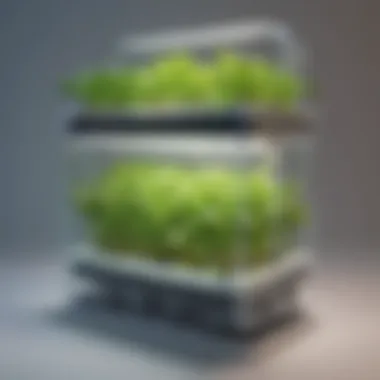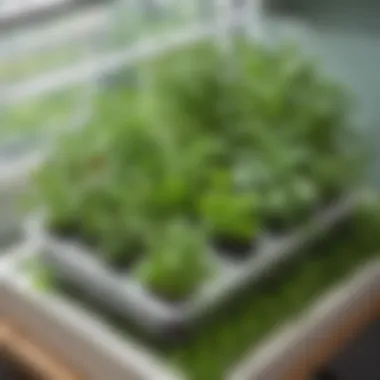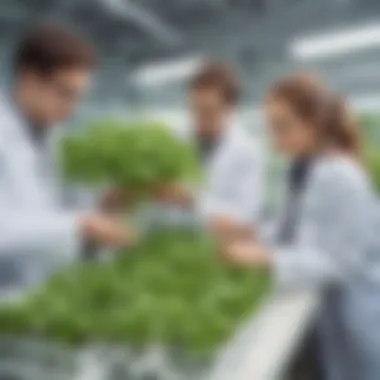Exploring Mini Hydroponics: A Fun Guide for Young Scientists


Intro
Mini hydroponics opens up exciting doors in how we think about growing plants. This method uses a water-based nutrient solution, allowing plants to grow without traditional soil. It's more efficient, often offering faster growth rates than conventional gardening. This approach is especially appealing to young scientists. By experimenting with mini hydroponics, children can learn important lessons about plant biology and chemical interactions. This guide will invite young minds to explore this topic hands-on, encouraging curiosity while providing insights that are essential in understanding science.
Science Fun Facts
Interesting Trivia and Facts
- Plants Can Grow in Water: Hydroponics allows for rich growth without dirt. Plants can absorb nutrients directly from the nutrient solution, leading to healthier growth.
- Faster Growth Rates: In ideal conditions, hydroponic plants can grow up to 50% faster than those grown in soil.
- Big Yield in Small Space: Mini hydroponics systems can produce about three times more crops than soil farming, making it perfect for limited spaces.
Quirky Science Stories
One time, scientists realized that certain plants could not only grow in water but also thrive. It started as an experiment in an outdated shed that was never meant for agriculture. Before long, this small, forgotten space turned into a lush mini garden, attracting curiosity from many.
Amazing Science Records
The world record for the largest tomato plant grown hydroponically is astonishing! One community project grew a tomato plant that produced an outrageous number of tomatoes, surpassing the average expected. It showed what dedication and hydroponic techniques could achieve in the field of gardening.
Thought-Provoking Questions
- How would plants determine what nutrients to absorb in a hydroponic environment?
- Why do you think plants can grow so quickly without soil, compared to soil-grown plants?
Discover the Wonders of Science
Exploring Various Scientific Concepts
Mini hydroponics engages several core scientific concepts, such as ecology, biology, and chemistry. Children discover the planet's cycles of growth while practicing responsibility by nurturing living organisms. They observe firsthand how light, water, and nutrients cooperate in plant development.
Educational Videos and Animations
Organizations like the Hydroponics Society and various educational channels on YouTube offer interactive videos explaining hydroponics easily. Visual learning can spark imagination and further understanding about the complexities of mini systems.
Interactive Learning Tools
Teaching platforms often promote tools like quizzes or virtual gardens. Such tools allow children to experiment freely—swapping variables to see how it affects plant growth and health. Tools like Kahoot! can provide instant feedback, motivating students to learn further.
Real-Life Applications of Science
Many cities are trying out urban gardening. Schools and households grow vegetables on rooftops or in backyards using hydroponic methods. This not only provides fresh food but also helps communities learn about sustainability and reduces their carbon footprint.
Science Quiz Time
Interactive Quizzes
Kids can test their knowledge after learning about hydroponics. Many websites have quiz sections where they can answer questions regarding plant biology and growth processes.
Multiple Choice Questions
- Which of the following is a benefit of hydroponics?
a) Decreases yield
b) Increases growth speed
c) Requires more land
d) Increased water fight - What can you grow using a mini hydroponic system?
a) Herbs
b) Trees
c) Soil-requiring plants
d) None
Answer: b) Increases growth speed
Answer: a) Herbs
Brain Teasers and Puzzles
Engaging puzzles often await hydroponics enthusiasts. Breaking down the components needed in this growing process is fun and intellectually stimulating!
Learning Through Gamification
Giiving students points for completing various challenges can effectively keep them engaged. With gamified learning, students explore mini hydroponics topics throughout their science curricula.
Science Experiment Showcase
Fun and Engaging Experiments
Each young scientist can create small hydroponic setups using inexpensive materials. Simple experiments can help illustrate the growth of different plants in water solutions.
Step-by-Step Instructions
- Fill a container with water and nutrient solution.
- Using rock wool or another medium, support small plant cuttings above the solution.
- Place in a well-lit area but away from direct sunlight. Monitor growth often.
Materials List
- A transparent container
- Nutrient solution
- Seedlings or seeds e- Rock wool or other supportive material
- Light source


Safety Tips and Precautions
- Be careful with nutrient solutions. They recommend wearing gloves and washing hands afterward.
- Ensure that the setup is stable to prevent spills.
This journey into mini hydroponics provides an engaging, informative experience that fosters growth—both for plants and young scientists.
Understanding Hydroponics
Hydroponics is a method of growing plants without soil. It doesn't seem natural at first, but it's become an important part of modern agriculture. Understanding this topic is crucial, especially for young scientists who are curious about how food is produced. Hydroponic systems can be simpler to manage than traditional soil gardening, and they often yield plants quicker. The focus on hydroponics can lead young learners to appreciate the science behind growing food efficiently.
Definition and History
Hydroponics, derived from the Greek.words 'hydro' (water) and 'ponos' (labor), first gained attention behind its potential to grow plants efficiently. In the 1930s, scientists started to understand the benefits of this soil-less system. Over time, various methods were developed. Many researchers engaged in this innovative technique found it could produce healthier plants that used fewer resources.
The concept grew more popular with urban farming and sustainability movements. Cultivating crops without soil allows for year-round production regardless of climate. Some people set up tiny systems in their homes, attracting interest from educators and young aspiring scientists. This history shows how flexible hydroponics is and how much it can contribute to food security.
Basic Principles of Hydroponics
There are several key principles that define how hydroponics works. Here are some elements:
- Growing Medium: Unlike soil, plants need a growing medium that retains moisture. Common materials include rock wool, clay pellets, or coconut coir.
- Nutrient Solution: This system feeds plants through water rich in essential nutrients. While it may sound technical, it simplifies obtaining what plants require.
- Light: Just like in soil gardening, light is essential. Natural sunlight works great, but fluorescent or LED grow lights can help too.
These principles make hydroponics accessible and intuitive for young and old. Teaching these concepts not only introduces gardening but encourages young scientists to engage with various skills. When young learners explore hydroponics, they learn about plants, biology, and the environment all at once.
Key Insight: Understanding hydroponics offers young scientists valuable insights into modern agricultural practices. It encourages critical thinking as they create their systems and learn through hands-on experience.
What is Mini Hydroponics?
Mini hydroponics is an innovative approach to growing plants without soil, utilizing a nutrient-rich water solution instead. This method has various advantages and caters to diverse environments, making it an important topic for young scientists to understand. By exploring mini hydroponics, young learners can gain insights into science, ecology, and agriculture, which are increasingly relevant in a changing world.
This segment will demystify mini hydroponics. Understanding its characteristics and benefits builds a foundation for anyone interested in this unique gardening technique.
Characteristics of Mini Hydroponics
Mini hydroponics systems generally require less space compared to traditional gardening. They fit well in urban areas or small households where garden space is limited. Typical systems can fit on a countertop or even a window sill. This efficiency is significant since it allows the practice of gardening in a variety of settings.
Some key characteristics of mini hydroponics systems include:
- Compact Size: They are built to occupy small areas, allowing for indoor gardening or smaller outdoor setups.
- Easy Setup: Many kits available in the market are designed for beginners and children. This simplicity invites participation and success for those new to the methods.
- User-Friendly Nutrient Delivery: Nutrient solutions can be customized for specific plants, maximizing growth potential. Understanding what nutrients plants need is a great introduction to chemistry for young scientists.
- Support Structures: They often incorporate structures that allow plants to grow upright, such as nets or vertical setups. This provides a unique visual aesthetic and demonstrates how to use space effectively.
These characteristics illustrate why mini hydroponics is captivating. Children may find the hands-on experience enriching and fun, fostering their interest in scientific learning.
Why Choose Mini Hydroponics?
Opting for mini hydroponics provides plenty of benefits. It promotes a sense of responsibility and understanding about the life cycle of plants. Here are compelling reasons to explore this method further:
- Sustainable Gardening: Without soil, there is less risk of pests and diseases, making mini hydroponics an appealing choice for eco-friendly practices.
- Educational Value: Mini hydroponics provides an engaging way for young minds to learn about plant biology and environmental stewardship. This knowledge nurtures curious minds.
- Year-Round Gardening: These systems can be maintained indoors, allowing for gardening throughout the year regardless of weather.
- Faster Growth: Plants grow more quickly in these systems as their roots go directly into nutrient solutions, which leads to faster and healthier plant growth.
- Increased Harvest: Due to the efficient use of space and control over growing conditions, mini hydroponic systems can yield higher amounts of produce than traditional methods.
Mini hydroponics not only saves space but also opens the doors to scientific exploration. Young scientists will be motivated to make observations, learn hands-on, and understand biological processes firsthand.
These benefits not only awaken an interest in science but also lay the groundwork for future sustainable practices.
Benefits of Mini Hydroponics
Mini hydroponics offers several advantages that make it a popular choice for aspiring young scientists. This section delves into various benefits of small-scale hydroponic systems, helping comprehend why this approach to gardening attracts attention from parents, educators, and children alike.
Space Efficiency
Mini hydroponics systems occupy much less space compared to traditional soil-based gardens. This is particularly beneficial for urban dwellers with limited room for gardening. In many instances, these systems can be set up indoors, allowing for year-round growing.
- Vertical Growth - Many mini hydroponic setups use vertical designs. This maximizes the growth area without needing more ground space.
- Compact Sizes - Simply put, mini hydroponic kits are available in different sizes that can fit on windowsills, desks, or kitchen counters. This provides new gardeners with an easy way to start trying their hand at growing plants.
“Space-efficient designs are a game-changer for those who like growing plants without needing gardens.”
Reduced Water Usage
Another significant benefit of mini hydroponics is the efficiency in water use. More traditional gardening methods often require extensive watering routines. In contrast, hydroponic systems significantly lower the amount of water spent.
- Recycling - Advanced setups recirculate water, reducing waste.
- Optimal Delivery - Nutrient solutions delivered directly to plants’ roots minimize evaporation and limit the need for additional watering.
- Less Soil Mess - Not using soil keeps the water cleaner and reusability increases, leading to smarter water management overall.
This principle makes mini hydroponics particularly appealing during periods of drought or in environments where water conservation is necessary.
Faster Growth Rates
Finally, mini hydroponics contributes to more rapid growth rates among plants. The exact reasons include easier regulation of essential factors such as light and nutrients.
- Nutrient Absorption – In hydroponics, plants can absorb nutrients more readily because they are dissolved in the water. This ensures more efficient nourishment.
- Controlled Environment – Mini systems allow for the control over important conditions that speed up growth.
- Limited Root Competition – The plants cultivated are given ample nutrients with little competition for resources.


- Light exposure can be optimized.
- Nutrient levels can be meticulously balanced.
This means that new mini hydroponic gardeners can see their plants thriving far quicker than with traditional farming methods.
In summary, understanding the benefits of mini hydroponics can be a stepping stone towards engaging with this gardening method. Young scientists will find both motivation and valuable learning experiences by exploring these unique advantages.
Components of a Mini Hydroponics System
Mini hydroponics involves several important elements that combine to create a successful growing environment for plants. Understanding these components helps young scientists grasp how plants can thrive without the typical soil medium. Each element plays a specific role, and their detailed knowledge can empower effective and sustainable growth in mini hydroponic systems.
Growing Mediums
In mini hydroponics, the growing medium is a crucial aspect. Unlike traditional soil, which harbors nutrients and supports roots, hydroponic systems use alternatives that can offer superior support for plant growth.
Here are some common types of growing mediums suitable for mini hydroponics:
- Coco Coir: Made from coconut husks, this organic medium retains water well while providing excellent aeration.
- Rockwool: Created from volcanic rock, this is commonly used for seedlings. Its structure holds moisture and oxygen, benefiting young plants.
- Perlite: This lightweight volcanic glass improves drainage and aeration for roots, ensuring no excess water clogs the system.
- Hydroton: These clay pebbles provide great drainage and air circulation. They are reusable and easy to work with.
Choosing the right growing medium affects not only water retention but also the oxygen supply to the roots. This is vital for keeping plants healthy and productive.
Nutrient Solutions
Another significant component of mini hydroponics is nutrient solutions. Plants require nutrients to grow, and hydroponic systems deliver them in water-soluble forms. By directly feeding the root systems, plants absorb essential minerals without competing with soil for nutrient space.
Common components of nutrient solutions include:
- Nitrogen (N): Important for plant growth and leaf development.
- Phosphorus (P): Crucial for flower and fruit development.
- Potassium (K): Aids in overall plant function, including water regulation and disease resistance.
There are premade nutrient solutions available for various plant types, making it easier for young scientists to start their hydroponics. Mixing and managing these nutrients is key to successful hydroponic gardening.
Water Supply and Drainage
For any hydroponics setup, an adequate water supply and drainage system is vital. Plants need a consistent supply of fresh, oxygenated water. Additionally, a proper drainage system prevents waterlogging, which can lead to root rot and other diseases.
Considerations include:
- Reservoir Size: A larger reservoir will hold more water and nutrients, ensuring plants receive longer-lasting supplies. Smaller reservoirs mean more frequent checks and refills.
- Pump Selection: Tiny water pumps circulate nutrient solutions throughout the system. Choosing the right pump size ensures adequate delivery without wasting energy.
- Drainage Plans: Draining excess water effectively can maintain optimal moisture levels. Holes or slits at the base of containers aid in proper drainage.
Light Requirements
Plants grew using hydroponics also need light to facilitate photosynthesis. Determining ideal light requirements for each specific plant can optimize growth.Lights such as LED, fluorescent, or incandescent can all enhance the photosynthetic process, critical for plant health. Different plants can mandate different light conditions.
Here’s what to keep in mind regarding lights:
- Light Hours: Most plants require 12-16 hours of light daily. Adjusting exposure time can modify growth rates.
- Distance to Plants: Keeping lights too close can scorch leaves, while too far may not provide enough energy for growth.
- Full-Spectrum Lights: These are often beneficial as they mimic sunlight, providing all wavelengths required by plants.
It’s essential to monitor how different factors influence plant responses. Good lighting can make a considerable difference in yield and health in mini hydroponic systems.
Understanding these components offers budding scientists insight into the seamless blend of technology and nature. It illustrates how controlled environments can lead to productive gardening practices, despite limited resources. By managing these aspects effectively, young gardeners pave the path for healthy plant life without conventional methods.
Setting Up a Mini Hydroponics System
Setting up a mini hydroponics system is an exciting and crucial aspect of this guide. This process serves as the bridge between simple theory and active growth. Young scientists will appreciate the hands-on experience of crafting their own systems where they can observe plant development first-hand. Additionally, a well-structured setup can ensure higher success rates in growing plants, which boosts confidence and interest.
Hydroponics might seem complex at first, however setting up a mini version allows even beginners to explore this scientific field. It teaches responsibility as tending to a system requires regular checks. This gentle commitment nourishes curiosity about plant biology and encourages a sense of achievement right from germination to harvest.
Materials Needed
To start, all one needs are basic materials. Here’s what you will need:
- Container: A plastic storage container or small buckets work well. Ensure that it can hold water securely.
- Growing medium: Options include rock wool, clay pellets, or coconut coir. Each has unique benefits, making selection interesting.
- Nutrient solution: Hydroponic nutrients come in liquid form. They provide essential minerals required for plant growth.
- Water: Ideally tap water should be treated. Make it chlorine-free because chlorine can harm roots.
- Air pump or sponge: Using an air pump creates bubbles that provide oxygen to the plants in their water medium.
- Lighting: Natural sunlight is best, but a grow light can supplement if there’s not enough light. LED grow lights are energy-efficient choices.
- pH test kit: It�’s vital to maintain the correct acidity levels of the solution.
- Seeds or starter plants: Select easy-growing herbs or leafy greens, they adapt well to hydroponic systems.
Step-by-Step Setup Instructions
Setting up a mini hydroponics system is simple and straightforward. Follow these instructions carefully:
- Choose your container: Find a suitable container that can hold your water and will not leak.
- Prepare the growing medium: Depending on your choice, place a layer of rock wool, clay pellets, or coconut coir in the container.
- Create a water solution: Dissolve the nutrient solution into your water following package instructions. Carefully mix it to ensure balance.
- Attach air pump if available: If using an air pump, ensure it is submerged in the water. This part is critical to ensure your plants receive enough oxygen.
- Set up lighting: Place your container in a location with sufficient light. If supplementing with a grow light, position it approximately 6-12 inches above the plants.
- Seed your plants: Plant the seeds or starter plants into the growing medium making sure they have adequate space.
- Monitor and maintain: Finally, regularly check the water levels and balance nutrient solution as necessary. Measure pH and adjust accordingly.
It should be very rewarding to watch your effort pay off with the growth of healthy plants. Engage with mini hydroponics while learning practical science. Through it all, understanding the basic concepts will develop pathways for future scientific exploration.
Plant Selection for Mini Hydroponics
Choosing the right plants is crucial for anyone diving into mini hydroponics. Plant selection directly affects not only the growth potential but also the overall success of system being setup. Young scientists should choose varieties that are resilient and easy to manage, especialy for initial experiments. Understanding which plants grow best in a soil-free environment equips aspiring gardeners with the foundational knowledge necessary in hydroponic gardening.
Best Plants for Beginners


When starting in mini hydroponics, it is advisable to select plants that have a reputation for thriving in such conditions. Here are some excellent options:
- Lettuce: A popular choice due to its quick growth cycles and adaptability, making it perfect for young experimenters.
- Basil: Its aromatic leaves are not only great for cooking but also grow well in hydroponic systems. This can spark interest in how plants can be utilized.
- Spinach: Fast-growing and nutritious, this plant can also be explored through many culinary dishes.
- Herbs: Many small herbs like mint, parsley, and cilantro thrive in mini hydroponics. This provides children opportunities for sensory exploration.
- Strawberries: Although slightly more challenging, choosing strawberries can add excitement, being visually appealing and rewarding to tend.
For any plant selection, soils practicality is absent and thus nutrient management becomes key. Each chosen plant will require unique nutrient solutions, and dismissing said factors could lead to unsatisfactory outcomes.
Seasonal Considerations
Understanding the seasons can greatly impact the success of mini hydroponics. Young scientists must grasp how plant growth varies throughout the year. This can help them choose which plants to cultivate and when. Here are a few key points to consider:
- Germination Rates: Different plants germinate at differing rates. Some require cooler conditions, whereas others perform better in warmth, so ensure a suitable environment.
- Light Availability: Seasons change hours of sunlight exposure. Therefore, interior lighting becomes more critical during winter months for growing plants effectively.
- Plant Productivity: Some plants, like herbs, flourish during summer. Considering seasonal yield can lead to better overall project outcomes.
In mini hydroponics, recognizing and adapting to seasonal conditions can principaly determine both plant health and production levels.
By taking the time to choose appropriate plants and considering the seasonal influences, kids not only engage with science concepts but also witness growth firsthand in a controlled environment. Learning these fundamentals will serve them well in all aspects of science, blending discussions of biology with real-world applications.
Care and Maintenance of Mini Hydroponics
Taking care of a mini hydroponics system is essential for success. Good care ensures plants grow healthy and yields are high. Proper maintenance also helps avoid problems, which is important for young scientists learning about growing systems. Regular scouting in the unit can encourage curiosity and responsibility toward plants.
Nutrient Management
Managing nutrients in hydroponics is vital for plant health. Plants absorb nutrients directly from the water. The nutrient solution must be rich in the necessary vitamins and minerals. Commonly, nutrients like nitrogen, phosphorus and potassium are required. You can buy these nutrients ready-mixed or you can create your own solution.
- Follow Guidelines: Brands often provide instructions on how to mix the solutions correctly.
- Ratios Matter: Check ratios suitable for your specific plants.
- Regular Checking: Observe plants for signs of deficiencies or excess nutrients, and adjust accordingly.
Monitoring pH Levels
pH levels determine how well plants can absorb nutrients. This value should typically range between 5.5 and 6.5 in a hydroponics system.
- Test Often: Use a pH meter or test strips every week to ensure that the pH remains within the proper range.
- Control Buffers: Include acid or base solutions in case pH goes off balance. For example, you can use phosphoric acid to lower the pH.
- Watch for Plant Signs: Leaves turning yellow or brown can indicate pH issues.
Preventing Common Issues
Preventing problmes in mini hydroponics is crucial, especially for beginners. Some common issues include algae growth, root rot and pests.
- Clean Environment: Regularly clean the system and remove debris. This helps to counteract algae growth.
- Rotate Plants: Changing plant locations can reduce pest infestations as pests can become acclimated to a single guest.
- Inspect Roots: Check for indications of root rot regularly. Healthy roots are typically white and firm; brown or mushy roots indicate trouble.
Observing these simple care steps can greatly improve your hydroponic gardening experience and learning.
Safety Considerations
Understanding safety precautions is crucial when embarking on any scientific venture. This section will focus on key elements regarding safety in mini hydroponics practice, enabling young scientists to create a secure working environment.
Chemical Safety with Nutrients
In mini hydroponics, nutrient solutions play a pivotal role in promoting healthy plant growth. However, some nutrients can be hazardous if mishandled. It is important to teach children the safest way to handle these substances.
- Always Read Labels: Children should learn to always read the labels on nutrient solutions before use. Labels contain essential information about proper usage and possible hazards.
- Wear Gloves: Although some nutrients are safe, it is a good idea for young scientists to wear gloves when handling them. It reduces the risk of skin irritation.
- Store Properly: Nutrients should be stored in their original containers, in a cool, dry location. This prevents accidental spills and contamination.
- Keep Out of Reach: Nutrient solutions should be kept out of reach of younger siblings or pets to avoid any accidental exposure.
Teaching and practicing these safety techniques helps create a positive approach to learning about chemistry and nutrition, encouraging carefulness in scientific observations.
Handling Equipment Safely
While working with mini hydroponic setups, proper handling of equipment is necessary. Young scientists can concentrate on their experiments confidently if they understand how to work with their tools safely.
- Understand the Equipment: Children should familiarize themselves with how each item in their mini hydroponics system functions, from pumps to water containers. Knowing the purpose and operation of equipment minimizes errors and mishandling.
- Keep Workspaces Tidy: A clutter-free workspace reduces the chances of accidents. All items should have designated spaces.
- Use Proper Techniques: Children should be taught proper techniques for handling equipment, especially when pouring liquids or adjusting settings. This includes steady hand movements to avoid spilling nutrient solutions or water.
- Ask for Help: Emphasizing that seeking assistance is applying good judgment aids in creating a supportive learning atmosphere. It’s important for kids to know they can ask an adult if they feel uncertain about handling machinery or chemical solutions.
Maintaining vigilance around safety involves not just knowledge but also diligence. With every step taken towards practicing careful handling, the experience in mini hydroponics can become even more rewarding and educational.
Remember, safety is not just a necessity—it is a vital part of the scientific process. Always prioritize it while exploring new concepts in hydroponics and nature.
The Future of Mini Hydroponics
Mini hydroponics promises a significant leap in how we approach plant cultivation, especially given the challenges of modern agriculture. The focus on this area is more than just a trend; it encapsulates a movement toward sustainable practices and improved accessibility for learners. Across the globe, awareness about environmental care and food security continues to grow. The future of mini hydroponics presents an exciting intersection of technology, education, and urban rural transitions.
Advancements in Technology
The acceleration in technology enhancement is reshaping mini hydroponics systems. New tools and approaches simplify the growing process. For instance, automated nutrient delivery and lower energy consumption LEDs create more efficient gardens.
- Smart systems: Digital hydroponics optimize water and nutrients using sensors and automation. This reduces the manual work involved and increases success rates, makes resources accessible for children and families alike.
- Mobile applications: Many mini hydroponics setups now connect to apps enabling real-time feedback on plant health. These tools help users track growth patterns.
- Lighter materials: Innovations in building materials make the systems more compact and portable. This portability encourages young scientists to explore their creativity.
These advancements not only foster fascination but also serve as educational tools. Encouraging kids to experiment, they naturally develop critical thinking alongside gardening skills.
Potential in Urban Agriculture
Urban agriculture is expanding rapidly. Mini hydroponics plays a vital role in this growth movement by providing opportunities to cultivate fresh produce where space is limited. Mini settings offer several advantages.
- Enhanced food security: Local food production can significantly reduce reliance on imported items. Classrooms or small homes can turn into self-sustaining produce sources.
- Education at the forefront: As families engage in mini hydroponics projects, they can incorporate lessons of biology, sustainability, and environmental science. Learning becomes a tactile and impactful experience, essential for young minds.
- Community engagement: Projects can inspire communities to come together. City gardens and mini hydroponics clubs allow sharing and exchanging knowledge and produce.
As cities continue to grow, the potential for mini hydroponics also expands, creating an eco-friendlier way of life for communities nationwide.
The convergence of education, technology, and sustainability shapes a vivid future for all budding scientists eager to explore mini hydroponics. With continued investment in these systems, each new generation can reap the fruits of their labor.







